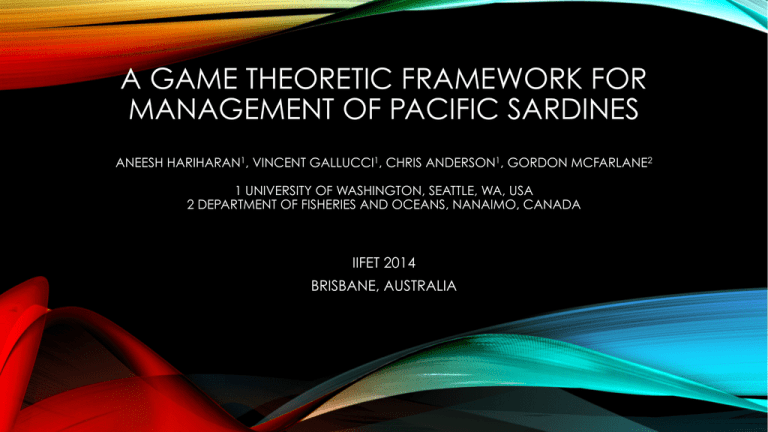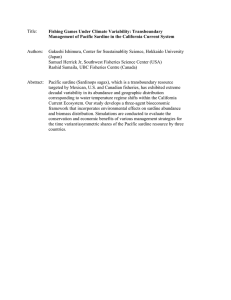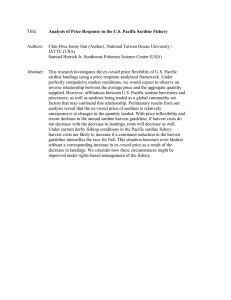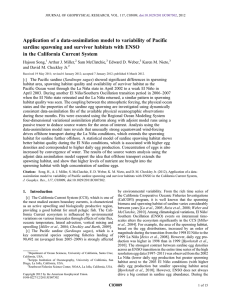A GAME THEORETIC FRAMEWORK FOR MANAGEMENT OF PACIFIC SARDINES
advertisement

A GAME THEORETIC FRAMEWORK FOR MANAGEMENT OF PACIFIC SARDINES ANEESH HARIHARAN1, VINCENT GALLUCCI1, CHRIS ANDERSON1, GORDON MCFARLANE2 1 UNIVERSITY OF WASHINGTON, SEATTLE, WA, USA 2 DEPARTMENT OF FISHERIES AND OCEANS, NANAIMO, CANADA IIFET 2014 BRISBANE, AUSTRALIA OUTLINE OF THE TALK • Biology and Ecology of the Pacific sardine • Model and Mathematics • Simulations • Results • Next steps PACIFIC SARDINE Fig: Mar-May 2014 Pacific sardine survey cruise. Courtesy (NOAA SWFSC Pacific sardine SAFE) • Small pelagic schooling fish. • Migrates up and down the Pacific West coast. • Juveniles spawn South (Southern California and Mexico), population expands northwards and migrate back down again. • Stock assessment: Highly correlated with Sea Surface Temperature (SST) PACIFIC SARDINE FISHERY • Fishery is shared by 3 nations: Canada, USA and Mexico. Stakeholders: Sardine fishing associations of 1. USA • California (CA) • Oregon (OR) • Washington(WA) 2. Canada (British Columbia) • 4 ‘agents’ (In this talk, only USA (WA) and Canada will be considered) • Management requires balancing the Pacific sardine fish stock and optimization of harvest rates. MODELING OUTLINE • Tools: Optimal control theory coupled with simulated games • Principal behind Optimal control game theoretic models (1) Maximize: Present Value of a quasi-rent function (2) subject to A Stock Harvest Constraint. • Two scenarios: Competitive games, cooperative games with bargaining and side payments. MODELING (MATHEMATICS) A sample 2 player optimal control problem for a competitive game (for agent 1). Algorithm: 1. Determine harvest strategy for each agent to maximize quasi rent generated in a non-cooperative/ competitive game. 2. Use quasi rents generated in the competitive scenario as threat points in a cooperative game to determine the Nash Bargaining Solution. 3. Use simulations to determine when a competitive game might be a better off strategy than a cooperative game for an exogenous bargaining strategy. MODELING ASSUMPTIONS • Catch is modeled as a Cobb-Douglas (non linear) production function for each region. • No explicit spatial component. • Effort is quantified as vessel days fished. • Competitive behavior hypothesis- Short term interests of each player coupled with Pacific sardine resource evolution. SIMULATION DETAILS • In this talk (2 players)- WA and BC • Inputs: Annual estimates of spawning biomass, total catch, region-wise catches, fishing days, price per unit ton, discount rates, cost per unit effort. • Output: Evolution of effort (vessel days fished in a year) and evolution of stock size over a finite time horizon for every agent. • Indicator for comparing cooperative and non-cooperative scenarios: Quasi rents generated. • Parameter β represents the “bargaining power” for WA. Thus, 1- β represents “bargaining power” for BC. Exogenous to the system. RESULTS: HARVEST FUNCTIONS • Predicted and observed catch for each agent OUTPUT FROM SIMULATED MODEL 10 years Non cooperative (million USD) Cooperative (million USD) β=0 0.15 0.3 0.5 0.7 0.85 1.0 Quasi rent (WA) 12.6 0 9.3 10.8 12.1 12.3 13.6 14.7 Quasi rent (BC) 50.4 62.7 58.4 57.8 57.3 54.2 52.9 0 Total 63.0 62.7 67.7 68.6 69.4 66.5 66.5 14.7 IMPLICATIONS • BC will always be interested in cooperation (except when WA has full bargaining power). • No side payment: WA will only be interested in cooperation ONLY IF it has a sufficiently high β i.e. greater than 0.7! in a 10 year planning horizon. • The joint total quasi rent is maximized when both regions have close to equal bargaining power. Thus, both patties will gain with a transfer of side payment. • With side payment: A transfer of 3.7 million USD from BC to WA, will yield a cooperative agreement with both agents mutually profiting. (BC=53.6 million USD and WA=15.8 million USD) • Overall (sum of quasi rents) in a cooperative scenario generate higher quasi rents than a competitive scenario. FUTURE WORK • Depending on availability of data, add Mexico as a player. • Sensitivity analysis to identify key driving parameters. • Incorporate a spatial component where the fish migrate up and down the coast, hence leading to a sequential game (Stackelberg) (Long et.al. IIFET 2010, Montpellier, France). ACKNOWLDGEMENTS • W.E. Lorne Clayton, Pacific Sardine Association (for funding this research). • Data : Jordan Mah (DFO, Nanaimo), Loran Wargo (DFW, Washington), Cyries Schmidt (Oregon Fish and Wildlife), Kirk Lynn (California Fish and Wildlife) • Chris Anderson lab members (UW Seattle) QUESTIONS?




